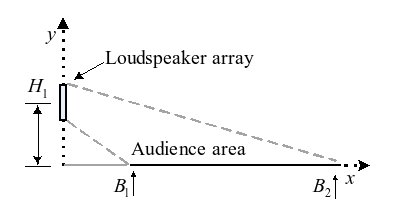Loudspeaker arrays have been widely used in all kinds of sound reinforcement applications to achieve uniform sound pressure level (SPL) distribution and high signal to noise ratio over the audience area. The least squares (LS) method is originally used in sound field reproduction applications. And loudspeaker weights obtained by LS method are calculated in the frequency domain.
Researchers from the Institute of Acoustics, Chinese Academy of Sciences find a practical problem that the radiated acoustic energy intensity over the audience area decline in low frequencies with conventional LS method. An approach based on energy contrast control is devised to solve this problem.
The traditional LS method is investigated. This method generates spatial sound field over the audience area with approximate to the desired SPL distribution using multiple-input multiple-output channel inversion. And effect of the loudspeaker arrays is optimized by minimization of the reproduction error on control points in the desired sound field.
In the following, a new solution based on energy contrast control is devised to solve the disadvantage of LS method mentioned above. Contrast between the acoustic energy over the audience area and the input energy of loudspeaker arrays is controlled to improve the SPL at low frequencies.
The new solution is verified both by simulations and experiments. Results show that the proposed method can improve acoustic energy at low frequencies without much impact on the uniform distribution of SPL at high frequencies.

Fig. 1 Application scenario of the sound reinforcement system (Image by LIU).

(a) (b)
Fig. 2 Experiment results against frequencies in the audience area. (a) Standard deviation of SPL; (b) acoustic energy (Image by LIU).
References:
LIU Li, CAI Yefeng, WU Ming, YANG Jun. Sound Reinforcement Technology Based on Sound Field Reconstruction with Energy Contrast Control. Proceedings of the 21st International Congress on Sound and Vibration, ISSN2329-3675/ISBN 978-83-62652-66-2, International Institute of Acoustics and Vibration (IIAV), R22-922, 2014.
Contact:
LIU Li
Key Laboratory of Noise and Vibration Research, Institute of Acoustics, Chinese Academy of
Sciences, Beijing 100190, China
E-mail: liuli@mail.ioa.ac.cn


